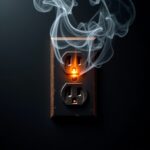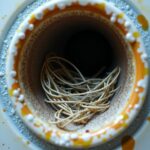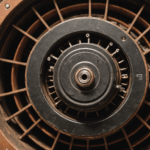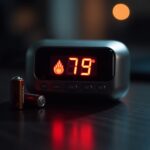Recognizing the signs of mold exposure is crucial for protecting your family’s health, as the Centers for Disease Control and Prevention (CDC) reports that indoor air quality can be significantly compromised by mold growth. The symptoms often mimic common allergies or cold symptoms, making them easy to dismiss or misdiagnose.
According to the Environmental Protection Agency (EPA), immediate or acute symptoms of mold exposure typically include:
- Persistent coughing and wheezing
- Nasal and sinus congestion
- Eye irritation, including redness, itching, and watering
- Throat irritation or soreness
- Skin rashes or irritation
- Headaches and frequent fatigue
- Difficulty concentrating or “brain fog”
Dr. Sarah Mitchell, an environmental health specialist at Stanford Medical Center, notes that chronic mold exposure can lead to more severe symptoms. “About 25% of people are genetically susceptible to mold-related illness, experiencing intense reactions to toxic mold exposure,” she explains. These individuals may develop chronic inflammatory response syndrome (CIRS), characterized by multiple system involvement.
Long-term exposure symptoms might manifest as:
- Memory problems and difficulty with concentration
- Joint pain and morning stiffness
- Digestive issues
- Anxiety and depression
- Sleep disorders
- Respiratory problems
A 2019 study published in the Journal of Environmental Health found that 85% of people experiencing these symptoms showed improvement after removing themselves from mold-contaminated environments. The World Health Organization (WHO) emphasizes that the timing of symptoms can be telling – if they appear or worsen in certain locations and improve when away, mold exposure could be the culprit.
Indoor air quality testing can confirm suspicions of mold presence. The American Industrial Hygiene Association recommends professional testing if you experience persistent symptoms, especially if they correlate with time spent in specific areas of your home. Keep a symptom diary to track when and where symptoms occur, as this information can be valuable for healthcare providers and mold remediation experts.
Understanding different types of toxic mold
Several dangerous mold species can colonize homes, each presenting unique health risks and requiring specific approaches for identification and removal. Stachybotrys chartarum, commonly known as black mold, is perhaps the most notorious variety, producing potent mycotoxins that can severely impact indoor air quality and cause significant health effects.
Aspergillus, another prevalent toxic mold, exists in multiple species and colors, ranging from green to black. The Environmental Protection Agency identifies this genus as particularly concerning because some species can produce aflatoxins, which are known carcinogens. Aspergillus niger, for instance, frequently appears in damp bathrooms and basements, while Aspergillus fumigatus often colonizes air conditioning systems.
Penicillium species, while famous for their medical benefits, can become problematic when growing indoors. These blue-green molds typically appear in water-damaged buildings and can produce mycotoxins that contribute to respiratory issues and allergic reactions. Research from the National Institute of Occupational Safety and Health indicates that prolonged exposure to Penicillium can lead to chronic respiratory conditions.
Chaetomium, often found in water-damaged drywall and carpeting, produces mycotoxins that can cause severe neurological symptoms. This mold typically starts white and becomes darker over time, emitting a distinctive musty odor. Studies show that chaetomium exposure can lead to particularly severe health effects in immunocompromised individuals.
The presence of Fusarium species often indicates significant moisture problems, as these molds require very wet conditions to thrive. Commonly found in soil and plants, Fusarium can infiltrate homes through damaged foundations or flooding, producing toxins that may cause both respiratory issues and skin infections.
- Black mold (Stachybotrys chartarum) requires humidity levels above 90% and typically grows on cellulose-rich materials like drywall and wood
- Aspergillus species can survive in temperatures ranging from 33-104°F, making them particularly adaptable to indoor environments
- Penicillium molds can spread rapidly, capable of colonizing an entire room within 48-72 hours under optimal conditions
- Color alone cannot determine mold toxicity – some harmless molds can be black, while some toxic varieties may be lighter in color
Health risks and vulnerable populations
Certain populations face significantly higher risks from mold exposure, with potentially severe health effects that can be life-altering or even life-threatening. Medical research has identified several groups who should be particularly vigilant about indoor air quality and mold prevention.
Infants and young children top the list of vulnerable individuals. Their developing immune systems and rapidly growing bodies make them especially susceptible to mold-related health problems. The American Academy of Pediatrics reports that children exposed to mold in their early years have a 30-50% higher risk of developing asthma and other respiratory conditions.
Elderly adults, particularly those over 65, form another high-risk group. Age-related decline in immune function, combined with the potential presence of other health conditions, can make mold exposure particularly dangerous. Studies show that seniors exposed to mold are more likely to develop serious respiratory infections and experience complications from existing conditions.
People with compromised immune systems face exceptional risks, including:
– Cancer patients undergoing chemotherapy
– Organ transplant recipients
– HIV/AIDS patients
– Those taking immunosuppressive medications
– Individuals with autoimmune disorders
Allergic or asthmatic individuals often experience intensified reactions to mold exposure. The American Lung Association notes that people with existing respiratory conditions may suffer severe asthma attacks or chronic bronchitis when exposed to even small amounts of mold.
Pregnant women require special consideration, as research indicates that mold exposure during pregnancy may increase the risk of:
– Preterm birth
– Low birth weight
– Respiratory problems in newborns
– Developmental issues
Healthcare providers emphasize that these vulnerable populations should maintain vigilant awareness of their environments and seek immediate medical attention if they experience any symptoms of mold exposure. Regular home inspections and prompt remediation of any moisture issues become particularly crucial for households with vulnerable members.
For these at-risk groups, the EPA recommends maintaining indoor humidity levels below 60% and ensuring proper ventilation in all living spaces. Air purifiers with HEPA filters can provide an additional layer of protection, though they should not be relied upon as the sole solution for mold problems.
Prevention and home inspection tips
Regular inspection and preventive measures are essential defenses against mold growth and can significantly improve indoor air quality. Start by conducting monthly visual inspections of areas prone to moisture, such as bathrooms, basements, and areas around windows. Use a humidity meter to maintain levels between 30-50%, as recommended by the EPA.
Key prevention strategies include:
– Installing proper ventilation systems in bathrooms and kitchens
– Using dehumidifiers in basements and crawl spaces
– Fixing leaks promptly, including hidden pipe issues
– Ensuring proper drainage around your home’s foundation
– Maintaining gutters and downspouts regularly
– Sealing windows and doors effectively
During home inspections, pay particular attention to these warning signs:
– Water stains on walls or ceilings
– Bubbling or peeling paint
– Musty odors
– Condensation on windows or pipes
– Warping of wood floors or trim
The EPA suggests creating a moisture control plan that includes:
1. Regular cleaning and drying of condensation
2. Proper insulation of cold surfaces
3. Immediate cleanup of water spills
4. Adequate ventilation during cooking and showering
5. Regular HVAC system maintenance
For thorough inspection, utilize these tools:
– Moisture meters for detecting hidden dampness
– Infrared cameras to identify temperature variations
– Air quality monitors to track humidity levels
– Surface sampling kits for suspicious areas
Professional inspectors recommend checking these often-overlooked areas:
– Behind furniture placed against exterior walls
– Under sinks and around plumbing fixtures
– Inside HVAC ducts and vents
– Around window frames and sills
– Behind appliances that use water
By implementing these preventive measures, homeowners can significantly reduce the risk of mold exposure and protect their family’s health. Schedule regular maintenance checks and address any moisture issues immediately – every day of delay increases the potential for mold growth and subsequent health effects. Remember that maintaining a mold-free home is an ongoing process that requires vigilance and prompt action.
Taking these proactive steps will not only protect your property value but also ensure a healthier living environment for you and your family. Make prevention a priority, and you’ll avoid the costly and potentially dangerous consequences of mold infestation.
Professional remediation and treatment options
- How much does professional mold remediation typically cost?
- Professional mold remediation costs typically range from $1,500 to $5,000, depending on the extent of contamination and the affected area size. The price may increase significantly if structural materials need replacement or if the mold has spread within walls.
- How can I tell if I need professional remediation versus DIY cleaning?
- Professional remediation is necessary when the affected area exceeds 10 square feet or if the mold growth is due to contaminated water. Additionally, if you’ve experienced significant health effects from mold exposure or if you have vulnerable family members, professional treatment is strongly recommended.
- What should I expect during the professional remediation process?
- The process typically begins with a thorough inspection and air quality testing, followed by containment of the affected area to prevent spore spread. Professionals will then remove contaminated materials, clean and treat the area, and perform post-remediation testing to ensure the space is safe.
- How long does professional mold remediation take?
- The duration varies based on the extent of contamination, but most residential projects take 3-7 days to complete. This includes time for demolition, cleaning, drying, and air quality testing to ensure the environment is safe.
- What credentials should I look for when hiring a mold remediation company?
- Look for companies certified by organizations like the Institute of Inspection Cleaning and Restoration Certification (IICRC) or the National Organization of Remediators and Mold Inspectors (NORMI). They should also have proper insurance, local licensing, and positive reviews from previous clients.











